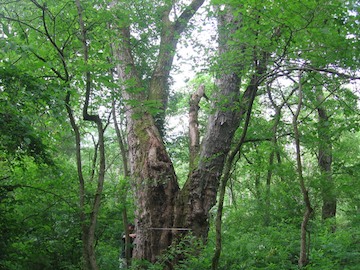
This silver maple at Green Ridge State Forest is the biggest Big Tree on Maryland public lands. Maryland DNR photo.
To mark its centennial, the Maryland Big Tree Program is offering $500 to whoever can find the biggest tree in a state forest.
In partnership with the Maryland Forest Service, the program is offering its Big-Tree Centennial Contest, encouraging the public to explore Maryland state forest and to report back on any trees larger than 15 feet in circumference. Top prize for finding the biggest tree – $500. Second gets $400, third gets $300, fourth gets $200 and fifth gets $100. Tree type doesn’t matter for this contest, only size.
The Maryland Big Tree program is a volunteer program currently celebrating its centennial. State-owned forests cover more than 200,000 acres, and are open year-round for activities such as hiking and bird-watching, as well as seasonally for hunting and trapping. The DNR website provides a map and list of state forests.
Contestants should note that in the Chesapeake Forest Lands on the lower Eastern Shore, only public hunting areas are open to explore, as some property is leased. Also, two Big Trees already identified in state forests – a silver maple in Green Ridge State Forest and a black oak in Elk Neck State Forest – are ineligible.
The contest runs Memorial Day Weekend through Labor Day Weekend, May 24 through Sept. 1, 2025. Trees found in any state forest are eligible, and the contest is open to residents and non-residents of Maryland. Complete details and rules are available on the contest webpage.
Some tips and techniques for contestants follow:
You will need a string, a marker, a measuring tape and a camera or cell phone. A hiking partner is recommended – this will make snapping photos easier if you find a big tree.
Before you hike, mark your string at 15 feet. When you have found a large tree, measure its circumference at 4-foot 6-inches above ground by wrapping the string around the tree. If your tree is larger than 15 feet, mark the string again and take a photo with the string around the tree plus someone standing next to the tree. Then, take four photos of the tree from each side. If possible, photograph the leaves.
Measure the new mark on the string using your measuring tape and take a photo of the string and tape together, showing the length. Use your phone to determine your GPS coordinates if possible.
Finally, report the circumference, location and photos to the Maryland Big Tree Program by contacting John Bennett at mdbigtreeprogram@aol.com.
